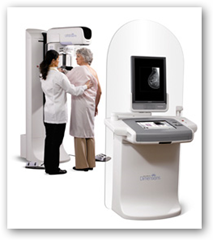The new devices also gives out twice the amount of radiation, which some say is ok if women do not have to have as many imaging done, thus less exposure. 
Hologic 3D Mammogram Reviewed by FDA and Determined 3D Mammograms Are Safe Even With Higher Levels of Radiation–If Approved by FDA - It’s a Software Upgrade from 2D to 3D
When I wrote about the device in September of 2010 it was stated that a software upgrade would allow the same device produce 3D images for customers who already own a device.
At present Hologic has FDA approval for the 2D machine and with an FDA approval most devices could be upgraded to the 3D capability. It’s a matter of a software upgrade, so the expertise of the FDA with programming and the assurance that the  bugs are out is essential. Radiation safety is upmost at the top of the list for safety as we read all the horrible over exposure stories in the news that killed people, the big stuff at Cedar Sinai. That was different machine and process but all devices that work with radiation need the same assurance.
bugs are out is essential. Radiation safety is upmost at the top of the list for safety as we read all the horrible over exposure stories in the news that killed people, the big stuff at Cedar Sinai. That was different machine and process but all devices that work with radiation need the same assurance.
Eventually 3D will become the norm but the FDA approval was given by allowing both 2D and 3D images to be created as many radiologists may need to train on the new imaging processes. In the meantime will there be a big rush to go out and acquire the new units which cost $150k more than the 2D device, maybe not now with everyone looking at their budgets. The director of research and quality care programs for the National Breast Cancer stated we don’t need more expensive imaging equipment now, we just need more sophistication. This was all over the news today I do have to agree as if it was something that was going to make an immediate huge difference, which it’s not, but in time 3D imaging will work it’s way into the processes to become standard. BD
Reporting from Washington — Three-dimensional mammogram technology, which could reduce the number of women who need additional screening for breast cancer, received approval Friday from the Food and Drug Administration.
But experts and advocacy groups were divided over how helpful the new images would be.
About 10% of women require follow-up screening because their first set of mammograms is not clear enough, which 3-D images might help resolve, said Kristin Byrne, chief of breast imaging for New York's Lenox Hill Hospital.
"I think it'll help us with patients that have dense breast tissue," said Byrne, predicting that 3-D imaging for breast cancer screening eventually will become standard.



0 comments :
Post a Comment